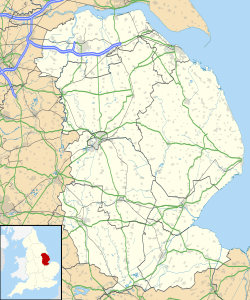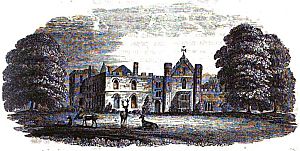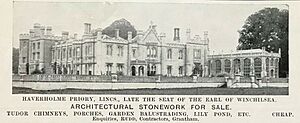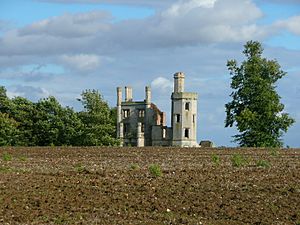Haverholme Priory facts for kids

Ruins of Haverholme Priory
|
|
| Monastery information | |
|---|---|
| Order | Cistercian 1137-1139 Gilbertine 1139-1538 |
| Established | 1137, 1139 |
| Disestablished | 1538 |
| Dedicated to | St Mary |
| People | |
| Founder(s) | Alexander, Bishop of Lincoln |
| Architecture | |
| Status | Monastery rebuilt as a house in the 1780s and 1830s, now ruined |
| Heritage designation | Scheduled Monument 1004984 Grade II listed building 1360563 |
| Site | |
| Location | Ewerby and Evedon, North Kesteven, Lincolnshire |
| Coordinates | 53°01′51″N 0°20′57″W / 53.030800°N 0.34930122°W |
Haverholme Priory was once a monastery in Lincolnshire, England. A monastery is a place where monks or nuns live and worship. Today, only ruins remain. You can find these ruins about 4 kilometers (2.5 miles) north-east of Sleaford. They are also less than 1 kilometer (0.6 miles) south-west of Anwick village.
Contents
Building the Priory
In 1137, a powerful church leader named Alexander, Bishop of Lincoln offered the land for Haverholme Priory. He wanted Cistercian monks from Fountains Abbey to build a monastery there.
The monks worked on the site for two years. But in 1139, they decided they didn't like the location. So, they left and built Louth Park Abbey instead.
After the Cistercians left, the site was offered to Gilbert of Sempringham. He was the founder of the Gilbertine order, which was unique in England. The Gilbertines sent both nuns and brothers from Sempringham to live at Haverholme. This made it a "double monastery," meaning both male and female religious communities lived there.
Life at Haverholme Priory
The Gilbertine monks and nuns at Haverholme had important jobs. They were in charge of keeping the nearby fen lands dry. Fens are low, marshy areas. They also had to run a foot ferry across the River Slea to Sleaford. This ferry was at a place called Ewerby Waith.
Sometimes, things didn't go smoothly. In 1316, the priory was called to explain why the ferry had fallen apart. They had to fix it.
Another interesting event happened in 1360. A woman named Alice Everingham was living at the Priory. People thought she had promised to become a nun. However, she left the Priory. When she was found, she told the Bishop that she had never taken vows and was being held against her will. The Bishop listened to her and ordered her to be set free.
There's also a story that in 1164, Thomas Becket might have hidden at Haverholme. This was during one of his disagreements with the King.
The Priory Closes Down
The priory's time ended in 1538. This was when King Henry VIII decided to close down many monasteries in England. This event is known as the Dissolution of the Monasteries.
After it closed, Haverholme Priory had many different owners over the next 250 years. Eventually, the Finch-Hatton family inherited it.
George Finch-Hatton, 10th Earl of Winchilsea rebuilt the priory in 1830. It became a large family home. The Finch-Hatton family lived there for almost 100 years.
Taking Down the Priory
By the early 1920s, the Finch-Hatton family faced financial difficulties. They decided to sell Haverholme Priory. However, no one wanted to buy it as a home.
Finally, a demolition company called RUDD of Grantham bought the property. Demolition means taking a building down. In 1926, RUDD sold most of the stone from Haverholme to an American woman. She planned to ship the stones to America and rebuild the priory there.
The stones were waiting on a dock in Liverpool to be shipped. But then, the buyer was in a train crash. Because of this, the stones were never sent to America. Instead, they were used to help build new docks in Liverpool.
What Remains Today
The ruins you see at Haverholme Priory today are from a Gothic-style building. It was built around 1835. The architect who designed it was Henry Edward Kendall. This building was actually a rebuild of an even older house from 1780.
These ruins are now protected. They are a Grade II listed building and an Ancient Monument. This means they are important historical sites that must be preserved.





